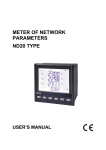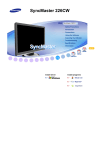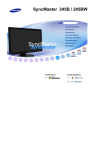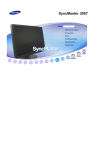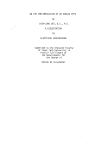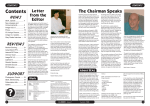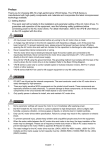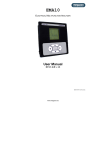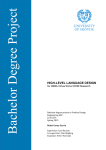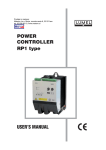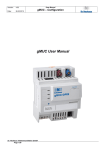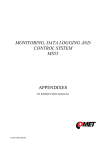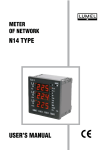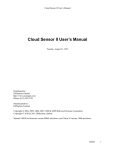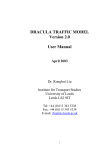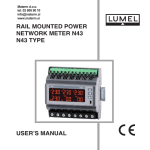Download meter of network parameters nd20 type user`s manual
Transcript
Materm d.o.o. tel: 02 608 90 10 [email protected] www.materm.si METER OF NETWORK PARAMETERS ND20 TYPE USER’S MANUAL Contents 1. APPLICATION .................................................................... 5 2. METER SET....................................................................... 6 3. BASIC REQUIREMENTS AND OPERATIONAL SAFETY...................... 6 4. INSTALLATION................................................................... 7 5. METER DESCRIPTION........................................................... 8 6. ND20 PROGRAMMING......................................................... 12 7. UPDATING OF SOFTWARE..................................................... 35 8. RS-485 INTERFACE............................................................. 37 9. ERROR CODES.................................................................. 60 10. TECHNICAL DATA............................................................... 62 11. VERSION CODES................................................................ 66 12. MAINTENANCE AND GUARANTEE............................................ 68 1. APPLICATION The N20D meter is a digital programmable panel meter destined for the measurement of single-phase power network parameters (2-wire network) and 3-phase, 3,4-wire network in balanced and unbalanced systems with the simultaneous display of measured quantities on a LCD display. The meter enables the control and optimization of power electronics devices, systems and industrial installation operations. The meter ensures the measurement of: rms values of voltage and current, active, reactive and apparent power, active, reactive energy, power factors, frequency, 15, 30, 60 minutes’ mean active power, archive of power profile, THD and harmonic measurements. Additionally, the current value in the neutral wire is calculated. Voltages and currents are multiplied by given voltage and current ratios of measuring transformers. Indications of power and energy take into consideration values of programmed ratios. The value of each measured quantity can be transmitted to the master system through the RS-485 interface. The relay output signals the overflow of the chosen quantity, and the pulse output can be used for the consumption check of 3-phase active and reactive energy. The meter has additionally a continuous current output. The meter has a galvanic separation between respective blocks: - supply, - measuring inputs, - voltage and current inputs, - analog output, - RS-485 output, - impulse output. 2. METER SET The set of the ND20 meter is composed of: 1. ND20 meter............................................ 1 pc. 2. user’s manual........................................ 1 pc. 3. guarantee card ...................................... 1 pc 4. seal......................................................... 1 pc. 5. holders to fix the meter in the panel.... 4 pcs 3. BASIC REQUIREMENTS AND OPERATIONAL SAFETY In the safety service scope, the ND20 meter meets to requirements of the EN 61010 -1 standard. Observations Concerning the Operational Safety: · All operations concerning transport, installation, and commissioning as well as maintenance, must be carried out by qualified, skilled per sonnel, and national regulations for the prevention of accidents must be observed. · Before switching the meter on, one must check the correctness of connection to the network. · Before removing the meter housing, one must switch the supply off and disconnect measuring circuits · The removal of the meter housing during the guarantee contract pe- riod may cause its cancellation. · The ND20 meter is destined to be installed and used in industrial electromagnetic environment conditions. · One must remember that in the building installation, a switch or a cir- cuit-breaker should be installed. This switch should be located near the device, easy accessible by the operator, and suitably marked. 4. INSTALLATION The ND20 meter is adapted to be fixed on a panel by means of holders. The fitting way is presented on the fig.1. Housing overall dimensions: 96 x 96 x 77 mm. At the rear side of the meter, there are screw terminal strips which enable the connection of external wires with a cross-section up to 2.5 mm2. One must prepare a 92.5+0.6 x 92.5+0.6 mm cut-out in the panel. The material thickness which the panel is made from should not exceed 15 mm. Insert the meter from the frontal panel side with the disconnected supply voltage. After the insertion into the hole, fix the meter by means of holders. Fig. 1. Meter fitting Fig. 2 Meter overall dimensions 5. METER DESCRIPTION 5.1 Current Inputs All current inputs are galvanically isolated (internal current transformers). The meter is adapted to co-operate with external measuring current transformers. Displayed current values and derivative quantities are automatically recoun in relation to the introduced external current transformer ratio. Current inputs are defined in the order as 1 A or 5 A. 5.2 Voltage Inputs Quantities on voltage inputs are automatically converted acc. to the introduced ratio of the external voltage transformer. Voltage inputs are defined in the order as 3 x 57.7/100 V, 3 x 230/400 V. 5.3 Connection Diagrams a) Direct, semi-direct and indirect single-phase measurement 8 b) Direct measurement in a 3-wire network Supply OUpulse OUA1 Semi-indirect measurement in a 3-wire network Supply OUpulse OUA1 Indirect measurement with the use of 3 current transformers and 2 or 3 voltage transformers in a 3- wire network c) Direct measurement in a 4-wire network. 10 Semi-indirect measurement in a 4-wire network. Indirect measurement with the use of 3 current transformers and 2 or 3 voltage transformers in a 4-wire network. Fig 3. Meter connection diagrams in a: a) single-phase network, b) 3-phase - 3 wire network, c) 3-phase - 4-wire network 11 6. ND20 PROGRAMMING 6.1 Frontal Panel 16 15 14 13 12 11 10 17 9 18 8 19 20 7 1 2 3 4 5 6 Fig 4. Frontal panel Description of the frontal panel: 1 – abandon push-button – ESC 2 – push-button to displace to the left 3 – push-button to decrease the value 4 – push-button to increase the value 5 – push-button to displace to the right 6 – acceptance push-button - ENTER 7 – symbol of displayed value of averaged active power 8 – display field of mean values, frequency, time, power guard 9 – display field of basic quantities, energy, THD, harmonics, date (rows 1, 2, 3) 10 – symbols indicating the display of power factor, power tangent and THD (row 4) 12 11 – units of displayed values 12 – symbols of digital data transmission 13 – multipliers of basic values 14 – symbols of alarm switching on/occurrence 15 – symbols of harmonic value, THD display 16 – symbols of energy flow 17 – symbols of min / max quantities 18 – symbols of quantity affiliation to respective phase 19 – symbols of power, energy character 20 – symbol of 3-phase quantity display 6.2 Messages after Switching the Supply on After switching the supply on, the meter performs the display test and display the ND20 meter name, rated current and voltage, the current program version, and next displays the measured values. where: n.nn is the number of the current program version or the number of the custommade version. Fig. 5. Message after starting the meter Caution! If on displays the message Err Cal or Err EE appears, one must contact the service shop. 6.3 Monitoring of Parameters In the measuring mode, quantities are displayed acc. to settled tables. The pressure of the push-button (left) or push-button (right) causes the transition between displayed quantities. The pressure of the push-button (Enter) causes the transition between mean and additional displayed values. The pressure of the push-button (down) causes the monitoring of the minimum value, however the pressure of the push-button (up) causes the monitoring of the maximum value. The pressure of the (ESC) push-button during the monitoring of these values, erases suitably minimum or maximum values. During the operation in the measuring mode of all harmonics (ALL-table 3), instead 13 of harmonic energy, harmonic percentage values are displayed. Through and push-buttons, one can switch between successive harmonics. The harmonic no is alternately displayed with the value. Through the RS-485 interface one can set up the values, that would be visualized (starting from version 1.02). The error display is described in the chapter 8. When displaying the reactive power, a marker indicating the load character is displayed, capacitive ( ) or inductive ( ) Displayed quantities in the field 9 (fig. 4.) for 3-phase 4-wire measurement mode 3Ph/4W and single-phase 1Ph/2W are presented in the table 1a and 1b. Table 1a L1, V L2, V L3, V L1-2, V L2-3, V L3-1, V row 1 U1 U121 I1 P1 Q1 S1 PF1 tg1 row 2 U21 U231 I21 P21 Q21 S21 PF21 tg21 row 3 U31 U311 I31 P31 Q31 S31 PF31 tg31 Displayed values Backlit symbols L1, A L2, A L3, A L1, W L2, W L3, W Displaying Displayed values Backlit symbols row 3 Displaying 14 L1, VA L2, VA L3, VA L1, PF L2, PF L3, PF L1, tg L2, tg L3, tg kWh Imported active energy2 EnP optional -, kWh kVarh kVarh Exported active energy 2 reactive inductive energy / reactive positive energy 2 reactive capacitive energy / reactive negative energy 2 row 1 row 2 L1, Var L2, Var L3, Var optional L1, U/ THD U L2, U/ THD U L3, U/ THD U L1, I/ THD I L2, I/ THD I L3, I/ THD I Uh1 V / THD1 % Ih1 A/ THD1 % Uh2 V / THD2 %1 Ih2 A/ THD2 %1 Uh3 V / THD3 %1 Ih3 A/ THD3 %1 Displayed values Backlit symbols kWh UI L1, U L2, U L3, U imported harmonic active. energy 1 Uh2n* %1 row 1 row 2 Uh1n* % -, kWh UI L1, I L2, I L3, I c exported harmonic active energy1 Uh1n* % cosinusj1 year P3phase 1 Uh2n* % 1 cosinusj2 1 month Q3phase 1 Uh3n* % 1 cosinusj3 1 day S3phase 1 Uh3n* % 1 row 3 Displaying W var VA optional * Harmonic voltage (current) of L1, L2, L3 phases for n-harmonic Displayed quantities in the field 8 (fig. 4.) Displayed symbols 3L, A A 3L, W 3L, var 3L, VA 3L, PF 3L, tg 3L, WAVG Displayed values in the row 4 Table 1b Imean 3phase1 I(N)1 P 3phase1 Q 3phase1 S 3phase1 PFmean 3phase1 tgmean 3phase1 P3phase (15, 30 or 60 min)2 Displaying optional Backlit symbols 3L, c Displayed values in the row 4 cosinus(j) 3phase 1 hour : minutes Hz % 3L, THD U 3L, THD I frequency Consumption of ordered power (in 15, 30 or 60 minutes’ time)2 Uhmean V/ THD Umean U %1 Ihmean A/ THD Imean U %1 Displaying optional In 1Ph/2W measurement mode: 1 - values are not calculated and not displayed, 2 - values calculated as corresponding values of first phase Displayed quantities in the field 9 (fig. 4.) for 3-phase 3-wire measurement mode 3Ph/3W and single-phase 1Ph/2W are presented in the table 2a and 2b. 15 Tablica 2a L1-2, V L2-3, V L3-1, V Backlit symbols Displayed values L1, A L2, A L3, A row 1 U12 row 2 U23 I2 row 3 U31 I3 kWh -, kWh kvar kvar exported active energy reactive inductive energy / reactive positive energy reactive capacitive energy / reactive negative energy I1 imported active energy Displaying optional W var VA Displayed symbols Displayed values row 1 year P3phase row 2 month Q3phase row 3 day Displaying S3phase optional Displayed quantities in the field 8 (fig. 4.) Table 2b Displayed symbols 3L, A 3L, W 3L, var 3L, VA 3L, PF 3L, tg 3L, WAVG Displayed values in the row 4 Imaen 3phase P 3phase Q 3phase S 3phase PFmean 3phase tgmean 3phase P3phase (15, 30 or 60 min) Displaying optional Backlit symbols 3L, c Displayed values in the row 4 cosinus(j) 3phase Displaying 16 hour : minutes Hz % frequency Consumption of ordered power (in 15, 30 or 60 minutes’ time) optional Performed calculations: Reactive power (the calculation method configured): Q = S 2 − P2 k ∑ ( ) or Q = U i * I i * sin ∠U i , I i where k – harmonic number (k = 21 dla 50 Hz, k = 18 dla 60 Hz) i =1 Power factor PF: PF = P / S Tangens power: tgϕ = Q / P Cosinus: cosinus between U and I The exceeding of the upper indication range is signaled on the display by upper horizontal lines, however the exceeding of the lower range is signaled by lower horizontal lines. In case of averaged power measurement P3-phase, single measurements are carried out with a 15 seconds’ quantum. Suitably to the 15 min, 30 min, 60 min selection, 60, 120 or 240 measurements are averaged. After starting the meter or the power erasing, the first value will be calculated after 15 seconds since the meter switching on or erasing. Till the time to obtain all active power samples, the value of averaged power is calculated from already measured samples. The current in the neutral wire I(N) is calculated from phase current vectors The value of consumed ordered power can be used for a previous warning against the exceeding of ordered power and to escape of fines related with it. The consumption of ordered power is calculated on the base of time interval set for the synchronization of the mean active power and the value of ordered power (section 6.5.1). the consumption example is presented in the section 6.5.3. The alarm switching on is signaled by the lighting of the AL1 inscription (in the mode AL1-3: of AL1, AL2, AL3 inscriptions). The end of alarm duration at the alarm signaling support switched on, is indicated by the pulsation of the AL1 inscription (in the mode AL1-3: of AL1, AL2, AL3 inscriptions). 17 6.4 Operating modes 18 Fig. 6. Operating modes of the ND20 meter. 6.5. Parameter Settings Fig 7. Setup menu The entry in the programming mode is carried out through the pressure and holding down of the push-button during ca 3 sec. The entry in the programming mode is protected by the access code. If there is not such a code, the program transits into the programming option. The inscription SET is displayed (in the first row) and the first group of PAr parameters. The monitoring of parameters is always available through the pressure and holding down the push-button during ca 3 sec. 19 20 dIsp Displayed values date Date and time alr Alarm parameters oUt Output parameters par Meter parameters al_n Three-phase ordered power p_or Exported harmonic energy enH- U_ln Phase voltages L-N t_H Hour, minute Quantity on the continuous output (table 6 in the user’s manual) mean THD of phase voltages tH3U cos Phase Cosinuses U_ll Voltages L-L t_d Month, day Alarm type al_t Type of continuous output an_t an_n Quantity on the continuous output (table 6 in the user’s manual) tr_1 Current ratio sec Access code tH3I mean THD of phase currents Date date I_ln Phase currents Year t_y alof Lower value of the input range an Il Lower value of the input range tr_U Voltage ratio on Display of parameters - ON Power P3phase, Q3phase, S3phase, p9s p Phase active powers alon Higher value of the input range an IH Higher value of the input range syn Synchronizing of the active mean power off Display of parameters - OFF I_a Threephase mean current 9 Phase reactive powers aldt Time delay of the switching reaction an0l Lower value of the output range nHar Number of the measured harmonic / THD 3p Power SP3phase pf Power factors PF phase Lock of alarm reswitching al_b antr Mode of output work 9_t Way to count reactive power 39 Power Q3phase tg Power phase Tangents tgj def Manufacturer’s parameters Output value when error aner En_9 Way to count reactive energy 35 Power Q3phase enp Imported active energy Quantity of impulses 1o_n lgHt Display backlight Threephase mean Power Factor PF pf_a Exported active energy enp- addr Address in MODBUS network En_0 Erasing of watthour meters Fig 8. Programming matrix. I_n Current in neutral wire s Phase apparent powers al_s Support of the alarm appearance signaling an0H Higher value of the output range erl1 Storage of the min/max value with errors tg_a Threephase mean Tangent en9 Reactive inductive energy tryb Transmission mode pa_0 Erasing of active mean power paug Power P3phase (15,30 or 60 minutes) en9- Reactive capacitive energy baUd Baud rate par0 Erasing of the active mean power archive Threephase mean Cosinus cosa THD of phase voltages tHdU def Manufacturer’s parameters Ordered power paor Hour HoUr tHdI THD of phase currents conn Type of system connection fre9 Frequency enH Imported harmonic energy def Manufacturer’s parameters 6.5.1 Setting of Meter Parameters Select the PAr mode in options (by and approve the choice by the or push-button. push-buttons) SEc oFF, 1 ... 60000 2 Ratio of the current transformer tr_I 1 ... 10000 3 4 5 6 Ratio of the voltage transformer tr_U Synchronization of mean active power Syn Number of the measured harmonic/ THD nHAr Storage of minimum and maximum values with errors erLI Manufacturer’s value Range Introduction of the access code Notes/ description Designation 1 Item Parameter name Table 3 0 - without code 0 1 0.1 ... 4000.0 15, c_15, c_30, c_60 tHd, ALL, 2 ... 21 oFF, on 1 Synchronization of mean active power: 15 - 15 minutes’ walking window (record synchronized with the clock every 15 minutes) c_15 – measurement synchronize with the clock every 15 minutes. c_30 – measurement synchronized with the clock every 30 minutes, c_60 – measurement synchronized with the clock every 60 minutes, 15 tHd – THD ALL – successive calculations of harmonics inserted in registers 2...21 – harmonic number ( in this mode, the active energy is calculated) tHd oFF – storage of only correct values (from the measuring range). on – storage of also error occurrences in measurements (values in registers 1e20 and 1e20) on 21 7 Way to calculate reactive power q_t trGLE, SInUS TrGle: Q = S 2 − P2 k SInUS: Q = ∑ U i * I i * sin (∠U i , I i ) trGLE i =1 k - harmonic number, k = 21 for 50 Hz, k = 18 for 60 Hz 8 Way to calculate reactive energy En_q cAP, SIGn cAP – inductive and capacitive energy SIGn – positive and negative energy Display backlit LGHt oFF, 1 .. 60, on off – disabled, on – enabled, 1..60 – time in seconds of backlit support since the push-button pressure. on Erasing of watt-hour meters En 0 no, EnP, Enq, EnH, ALL no – lack of actions, EnP – erasing of active energy, Enq – erasing of reactive energy, EnH – erasing of harmonic energy. ALL – erasing of all energy no 11 Erasing of mean active power PA 0 no, yES yES -erasing of power 12 Reset of mean active power archive PAr0 no, yES yES - erasing of archive Ordered power PAor 14 Measurement mode conn 3Ph-4, 3Ph-3, 1Ph-2 Meter connection way 15 Manufacturer’s parameters dEf no, yES Restoration of manufacturer’s parameters of the group. 9 10 13 cAP no no 0...144.0 Ordered power for forecasting the power consumption in % of the rated value 100.0 3Ph-4 no The automatic erasing of energy is carried out: - for active energy when changing: voltage or current ratio; - for reactive energy when changing: voltage or current ratio, the way of reactive power calculation; - for energy of harmonics when changing: voltage or current ratio, when changing the measured harmonic number. 22 Values are set by means of and push-buttons, however the position of the set digit is selected by means of and pushbuttons. The active position is signaled by the cursor. The value is accepted by the push-button and resigned by the pressure of the push-button. During the acceptation, the value insertion possibility in the range is checked. In case when the value is set beyond the range, the meter remains in the parameter edition mode, however the value is set on the maximum value (when the value is too higher) or on the minimum value (when the value is too lower). 6.5.2. Setting of Output Parameters Designation Range Notes/ description Manufacturer’s value 1 Quantity on the continuous output (code acc. to the table 6) An_n table 6 (the code acc. to the table 6) P 2 Type of continuous output An_t 0_20, 4_20 The selection 4_20 causes the switching on of the minimum output current limitation on the level ca 3.8 mA. 0_20 3 Lower value of the input range AnIL -144.0 ... 144.0 in % of the rated quantity value 0 4 Upper value of the input range AnIH -144.0 ... 144.0 in % of the rated quantity value 100.0 5 Lower value of the output range AnOL 0.00 ... 24.00 in mA 0 6 Upper value of the output range AnOH 0.00 ... 24.00 in mA 20 Item Parameter name Select the out mode in options and approve the choice by the push-button. Table 4 23 7 Output operation mode Antr nor, AnOL, AnOh Operating mode of the continuous output: nor – normal work, AnOL – set value AnOL, AnOH – set value AnOH, nor 8 Output value at error AnEr 0 ... 24 in mA 24 9 Number of impulses Io_n 1000 ... 20000 Number of impulses for 1 kWh 5000 10 Address in MODBUS network Addr 1 ... 247 1 11 Transmission mode trYb r8n2, r8E1, r8o1, r8n1 8n2 12 Baud rate bAUd 4.8 k, 9.6 k, 19.2 k, 38.4 k 9,6 k 13 Manufacturer’s parameters dEf no, yES Restoration of manufacturer’s parameters of the group no 6.5.3. Setting of Alarm Parameters Designation Range Quantity in the alarm output (code acc. to the table 6) AL_n table 6 2 24 Alarm type AL_t n-on, n-oFF, on,oFF, Hon, HoFF, AL1-3 Table 5 Manufacturer’s value Parameter name 1 Notes/ description Item Select the ALr mode in options and approve the choice by the push-button. P Fig. 9 n-on 3 Lower value of the input range ALoF -144.0 ... 144.0 in % of the rated quantity value 99 4 Upper value of the input range ALon -144.0 ... 144.0 in % of the rated quantity value 101 5 Time delay of the switching reaction ALdt 0 ... 900 in seconds (for quantities AL_n =P_ord the delay occurs only when switching the alarm on) 0 In the situation when the support function is enabled, after the retreat of the alarm state the alarm symbol is not blanked but begins to pulsate. In the AL1-3 alarm mode, the signaling support is always enabled, independently of the setting. The signaling exists till the moment of blanking it by means of the and push-buttons combination (during 3 seconds). The function concerns only and exclusively the alarm signaling, then relay contacts will be active without support, acc. to the selected type of alarm. 6 Support of the alarm occurrence signaling AL_S oFF, on 7 Interlocking of a renewed alarm switching on AL_b 0...900 in seconds 0 8 Manufacturer’s parameters dEF no, yES Restoration of manufacturer’s parameters of the group. no oFF The write of the value ALon lower than ALoF switches the alarm off. 25 Selection of the monitored value: Table 6 Item/ value in register 4015 Displayed parameter Kind of quantity 00 off 01 U_1 voltage of phase L1 02 I_1 current in the phase wire L1 03 P_1 active power of phase L1 04 q_1 reactive power of phase L1 Un x In x sin(90°) [var] * 05 S_1 apparent power of phase L1 Un x In [VA] * 06 PF1 active power factor PF of phase L1 07 tg1 tgj coefficient of phase L1 08 U_2 voltage of phase L2 09 I_2 current in the phase wire L2 10 P_2 active power of phase L2 11 q_2 reactive power of phase L2 Un x In x sin(90°) [var] * 12 S_2 apparent power of phase L2 Un x In [VA] * 13 PF2 active power factor PF of phase L2 14 tg2 tgj coefficient of phase L2 15 U_3 voltage of phase L3 16 I_3 current in the phase wire L3 17 P_3 active power of phase L3 18 q_3 reactive power of phase L3 Un x In x sin(90°) [var] * 19 S_3 apparent power of phase L3 Un x In [VA] * 20 PF3 active power factor PF of phase L3 26 lack of quantity /alarm disabled/ Value for the percentage conversion of alarm values and outputs (100%) none Un [V] * In [A] * Un x In x cos(0°) [W] * 1 1 Un [V] * In [A] * Un x In x cos(0°) [W] * 1 1 Un [V] * In [A] * Un x In x cos(0°) [W] * 1 21 tg3 22 U_A tgj coefficient of phase L3 mean 3-phase voltage 23 I_A mean 3-phase current In [A] * 24 P 3-phase active power (P1 + P2+ P3) 3 x Un x In x cos(0°) [W] * 25 q 3-phase reactive Power (Q1 + Q2 + Q3) 3 x Un x In x sin(90°) [var] * 26 S 3-phase apparent Power (S1 + S2 + S3 ) 3 x Un x In [VA] * 27 PF_A 3-phase active power factor PF 28 Tg_A 29 FrEq 3-phase tgj coefficient frequency 30 U12 phase-to-phase voltage L1-L2 31 U23 phase-to-phase voltage L2-L3 3 Un [V] * 3 Un [V] * 32 U31 phase-to-phase voltage L3-L1 3 Un [V] * 33 U4_A mean phase-to-phase voltage 34 P_At mean active power 35 P_ord Used percentage of the ordered active power (consumed energy) 1 Un [V] * 1 1 100 [Hz] 3 Un [V] * 3 x Un x In x cos(0°) [W] * 100% *Un, In – rated values of voltages and currents a) n-on 27 b) n-off c) On d) OFF Fig. 9. Alarm types: a),b) normal c) enabled d) disabled 28 Remaining types of the alarm: - H-on – always enabled; - H-oFF – always disabled, - AL1-3 – in this mode, the alarm quantity must be from the range:0-7.When the alarm appears on whichever phase, the relay will be enabled and the suitable symbol remains switched on ( AL1 – phase 1, AL2 – phase 2, AL3 – phase 3. It will be disabled only when all alarms disappear. Alarms operate in the n-on mode with identical hysteresis thresholds ALof and ALon for each phase.The alarm condition withdraw is signaled by the pulsation of the alarm symbol independently of the set support value of the alarm signaling. The blanking of the signaling support follows after pressing and push-buttons (during 3 sec). Example no 1 of alarm setting: Set the alarm of n-on type for the monitored quantity P – 3-phase active power, version 5 A; 3 x 230/400 V. Switching the alarm on, after exceeding 3800 W, switching the alarm off after decreasing 3100 W. Calculate: rated 3-phase active power: P = 3 x 230 V x 5 A = 3450 W 3450 W – 100 % 3450 W – 100 % 3800 W – ALon % 3100 W – ALoF % It appears: ALon = 110 % ALoF = 90 % Set: Monitored quantity: P; Kind of alarm: n-on, ALon 110, ALoF 90.0. Example no 2 of alarm setting: Set the alarm of earliest warning about the possibility to exceed the ordered 1 MW power on the level 90% at the one hour accounting. Measuring current transformer 2500/5 A, voltage :230 V, Instantaneous maximum import of power: 1.5 MW. Calculate: rated 3-phase active power of the ND20 meter: P = 3 x 230 V x 2500 A (500 * 5 A) = 1.725 MW (500 * 3450 W) – 100%; 90% of ordered power / rated power = 90.0% * 1 MW / 1.725 MW = 52.1 % of the rated meter value (rounding down). The’ ordered hourly power (energy for consumption): 1 MWh / 4 quarters = 900 MWs, 90% - 810 MWs. Remaining 10% at maximum power import would be used in time: 900 MWs / 1.5 MW = 60 s 29 Fig 10. Measurement of 60 minutes’ active power consumption synchronized with the clock, with alarm set on a 90% consumption. An example of the parameter value utilization of ordered active power to switch the alarm on is presented on the fig. 10. The time delay is set on 0 sec. In the calculated example, for remaining 10% of ordered power, at the maximum power consumption, devices could still work during 60 sec without exposing customers to fines. when setting the time delay ALdt on 60 sec, the alarm would not be enabled. Set: Monitored quantity: P_ord, Kind of alarm: n-on, ALon = 90.0, ALoF = 89.9, Tr_1 = 500, Syn = c_60, Time delay ALdt = 0 or 240 s. 6.5.4 Setting Date and Time Select the dAtE mode in options and approve the choice by the push-button. Seconds are reset after setting hour and minute values. Table 7 Parameter name Designation range Manufacturer’s value 1 Hour, minute t_H 0 ... 23, 0 ... 59 0.00 2 Month, day t_d 1 ... 12, 1 ... 31 1.01 3 Year t_y 2001 ... 2100 2001 Item 30 6.5.5. Setting of displayed values Manufacturer’s value Range No. Parameter name Designation Select the dISP mode in options and approve the choice by the push-button. Table 7 Displayed parameters in the row 1 - 3 1 Phase voltages U_Ln oFF, on on 2 Phase-to-phase voltages U_LL oFF, on on 3 Phase currents I_Ln oFF, on on 4 Active phase powers P oFF, on on 5 Reactive phase powers q oFF, on on 6 Apparent phase powers S oFF, on on 7 Phase PF power factors PF oFF, on on 8 Phase Tangents j factors tG oFF, on on 9 Input active energy EnP oFF, on on 10 Output active energy EnP- oFF, on on 11 Inductive reactive energy Enq oFF, on on 12 Capacity reactive energy Enq- oFF, on on 13 THD of phase voltage tHdu oFF, on on 14 THD of phase current tHdI oFF, on on 15 Harmonic input active energy EnH oFF, on on 16 Harmonic output active energy EnH- oFF, on on 17 Phase Cosinus j cos oFF, on on 18 Date date oFF, on on 31 19 3-phase active, reactive, apparent power 20 Three-phase mean current 21 Current in neutral wire 22 23 PqS oFF, on on I_A oFF, on on I_n oFF, on on Three-phase active power 3P oFF, on on Three-phase reactive power 3q oFF, on on 24 Three-phase apparent power 3S oFF, on on 25 Three-phase mean power factor PF PF_A oFF, on on 26 Three-phase mean Tangent j factor tG_A oFF, on on 27 Three-phase mean active power (15,30 or 60 minutes) PAvG oFF, on on 28 Three-phase mean Cosinus j coSA oFF, on on 29 Hour HoUr oFF, on on 30 Frequency Freq oFF, on on 31 Three-phase ordered power p_or oFF, on on 32 Mean THD of phase voltages tH3U oFF, on on 33 Mean THD of phase currents tH3l oFF, on on 34 Diplay of parameters - ON on no, YES no 35 Display of parameters - OFF off no, YES no Displayed parameters in the row 4 Note! When you turn off the display of all parameters, the phase current values and three-phase mean current are displayed. 32 6.6. Configuration of THD Measurement, Harmonics and Energy for the Harmonic The meter has 3 work modes related to the THD and harmonic calculation. When setting the parameter of the harmonic number: - tHd – the meter measures every 1 second only the THD value for currents and voltages, the result is exposed on the display and expressed in registers in percentages. Energy of harmonics is reset and particular harmonics include the error value (1e20); - All – the meter measures harmonics from 2 up to 21, for 50 Hz frequency (from 2 up to 18 for 60 Hz frequency). Energy of harmonics is reset. - 2 – 21 – measurement of the selected harmonic value, every 1 second, the result is exposed on the display and in basic units (V, A) in registers. Energy for the given harmonic is counted up. The switching of the harmonic number or the change of voltage or current ratio resets energy for harmonics. 6.7. Archive – Active Power Profile The ND20 meter is equipped with an archive allowing to store up to 9000 measurements of mean active power. Mean active power PAV is archived with a 15, 30, 60 minutes’ interval of time, synchronized with the real time clock. In case of operation in the 15 minutes’ walking window mode, the archiving is performed in the same way as for the 15 minutes’ interval of time (fig. 11). The direct access to the archive is for 15 records including the date, time and value placed in the range of addresses 1000 -1077. The position of the first (oldest) archived sample is placed in the register 1000, however the position of the last archived sample (youngest) is placed in the register 1001. the value of the first record, from 15 available records placed in registers 1003 – 1077, is written in the register 1002. The write of the first read out record value (1 – 9000) causes the data updating of 15 records for readout. In registers, in which samples were not already been written, are 1e20 values. 33 The archive is organized in the shape of a circular buffer. After writing the 9000 th value, the next overwrites the oldest with number 0, and the successive, the next with number 1, etc. If the value of the register 1000 is higher than 1001, that means that the buffer was overflowed one time at least. Eg, the value 15 in the register 1000, and 14 in the register 1001 means, that there were already more than nine thousand samples and oldest samples are from the record 15 up to 9000, next from the record 1 to the youngest record with number 14. The change of the current or voltage ratio, kind of mean power, causes the archive erasing. The reset of averaged power or the change of averaging time does not erase the archive. The automatic erasing of the archive and averaged power is performed when changing the voltage or current ratio. Fig. 11. Measurement of 15 minutes’ mean active power synchronized with the clock. 34 7. UPDATINGOFSOFTWARE Function enabling updating of software from the computer of the PC with software LPCon was implementation in meter ND20 (from software version 1.09). Free software LPCon and update files are accessible on the site www.lumel.com.pl. The connected to the computer converter RS485 is required on USB to the updating, e.g.: the converter PD10. a) b) Fig. . Program view: a) LPCon, b) updating of software Note! After updating the software, the manufacturer’s settings of the meter should be set, so it is recommended to save the meter parameters before updating using the software LPCon. After starting LPCon’s software COM port, baudrate, transmission mode and adress should be set. It can be done in Options. Then, ND20 meter should be selected from Device. Push icon Load to read and save current settings. Open window Lumel Updater (LU) – figure 13b from Updating>Updating of devices firmware. Push Connect. Update progress is shown in Messages section. Text Port opened appear after correctly opened port. Putting meter in update’s mode can be done in two ways: remote from LU (with settings from LPCon – port, baudrate, transmission mode and adress) or by turning power on while button pressed. Meter display shows the „boot” inscription with bootloader version, LU shows message „Device found” with name and current version of firmware. Using button browse to the meter upgrade file. If the file is opened correctly, a File opened message is displayed. Press the Send button. When upgrade is successfully completed, meter reverts to the default settings and begins normal operation while the information window displays Done message and upgrade elapsed time. Close LU and go to Restoration of default parameters. Select checkbox and press Apply button. After the LU window is closed, press the Save icon to save all initially read parameters. Current firmware version can be checked when meter is power on. Warning! Turning the meter off during upgrade process may result in permanent damage! 36 8. RS-485 INTERFACE The implemented protocol is compliant with the PI-MBUS-300 Rev G, Modicon. Parameter set of the serial ND20 meter link: · identifier 0xBC · meter address: 1..247 · baud rate 4.8, 9.6, 19.2, 38.4 kbit/s, · working mode Modbus RTU, · information unit 8N2, 8E1, 8O1, 8N1, · maximum response time 600 ms. · maximum quantity of read out registers in one request 41registers – 4 byte registers, 82 registers – 2 byte registers, · implemented functions 03, 04, 06, 16, 17, - 03, 04 - readout of registers, - 06 - write of one register, - 16 - write of n-registers, - 17 - device identification, Manufacturer’s settings: address 1, baud rate: 9600 baud, RTU 8N2 mode, Readout of n-registers (code 03h) Example 1 . Readout of 2 registers 16-bit of integer type, starting with the register with the 0FA0h (4000) address - register values 10, 100. Request: Device address Function 01 03 Register address Number of registers B1 B0 B1 B0 0F A0 00 02 CRC Control sum C7 3D 37 Response: Device address Function 01 03 Number of bytes Register address 0FA0 (4000) 04 Number of registers 0FA1 (4001) B1 B0 B1 B0 00 0A 00 64 CRC Control sum E4 6F Example 2 . Readout of 2 registers 32-bit of float type as 2 registers 16-bits, starting with the register with the 1B58h (7000) address - register values 10, 100. Request: Device address Function 01 03 Register address Number of registers B1 B0 B1 B0 1B 58 00 04 CRC Control sum C3 3E 01 Number of baytes Function Device address Response: 03 08 Value from register 1B58 (7000) Value from register 1B59 (7001) Value from register 1B5A (7002) Value from register 1B5B (7003) B3 B2 B1 B0 B3 B2 B1 B0 41 20 00 00 42 C8 00 00 CRC Control sum E4 6F Example 3 . Readout of 2 registers 32-bit of float type as 2 registers 16-bit, starting with the register with the 1770h (6000) address register values 10, 100. Request 38 Device address Function 01 03 Register address Number of registers B1 B0 B1 B0 17 70 00 04 CRC Control sum 4066 01 Number of bytes Function Device address Response: 03 08 Value from register 1770h (6000) Value from register 1770h (6000) Value from register 1772h (6002) Value from register 1772h (6002) B1 B0 B3 B2 B1 B0 B3 B2 00 00 41 20 00 00 42 C8 CRC Control sum E4 6F Example 4 . Readout of 2 registers 32-bit of float type, starting with the register with the 1D4Ch (7500) address - register values 10, 100. Request: Device address Function 01 03 Register address Number of registers B1 B0 B1 B0 1D 4C 00 02 CRC Control sum 03 B0 01 03 Value from register 1D4C (7500) Value from register 1D4D (7501) Number of bytes Device address Function Response: B3 B2 B1 B0 B3 B2 B1 B0 08 41 20 00 00 42 C8 00 00 CRC Control sum E4 6F Recording a single register (code 06h) Example 5 . Recording the value 543 (0x021F) in the register 4000 (0x0FA0) Request: Device address Function 01 06 Register address Number of registers B1 B0 B1 B0 0F A0 02 1F CRC Control sum CA 54 39 Response: Device address Function 01 Register address Number of registers B1 B0 B1 B0 0F A0 02 1F 06 CRC Control sum CA 54 Recording to n-registers (code 10h) Example 6 . Recording 2 registers starting with the register with the 0FA3h (4003) address recorded values 20, 2000. Register addr. Lo A3 Number of bytes 0F Register addr. Lo 10 Register addr. Hi 01 Register addr. Hi Function Device address Request: 00 02 04 Value for register 0FA3 (4003) Value for register 0FA4 (4004) B1 B0 B1 B0 00 14 07 D0 CRC Control sum BB 9A Response: Device address 01 Function 10 Register address B1 B0 B1 B0 0F A3 00 02 Report identifying the device (code 11h) Example 7 . Device identification Table 8 Request: Device address Function CRC Control sum 01 11 C0 2C 40 Number of registers CRC Control sum B2 FE 19 Device status 11 Identifier Number of bytes 01 Function Device address Response: BC Information field of the device software version (eg, „ND201.09 b-1.04” - ND20 device with software version 1.09 and bootloader version 1.04) FF 4E 44 32 30 2D 31 2E 30 39 20 20 20 20 20 20 20 62 2D 31 2E 30 34 20 CRC Control sum DB 42 Map of ND20 meter registers In the ND20 meter, data are placed in 16 and 32-bit registers. Process variables and meter parameters are placed in the address area of registers in a way depended on the variable value type. Bits in 16-bit registers are numbered from the youngest to the oldest (b0-b15). 32-bit registers include numbers of float type in IEEE-754 standard. Table 9 Address range Type of value Description 1000 – 1077 Integer (16 bits)/ record Archive of the averaged power profile. The table 10 includes the register description. 4000 – 4055 Integer (16 bits) The value is placed in one 16-bit register. The table 11 includes the register description. Registers for write and readout. 6000 – 6319 Float (2x 16 bits) Value placed in two successive 16-bit registers. Registers include the same data as 32-bit registers from the area 7500 – 7659. Registers for readout. Sequence of bytes (1-0-3-2). 6320 – 6573 Float (2x 16 bits) Value placed in two successive 16-bit registers. Registers include the same data as 32-bit registers from the area 7660 – 7786. Registers for readout. Sequence of bytes (1-0-3-2). 41 7000 – 7319 Float (2x16 bits) Value placed in two successive 16-bit registers. Registers include the same data as 32-bit registers from the area 7500 – 7659. Registers for readout. Sequence of bytes (3-2-1-0). 7500 – 7659 Float (32 bits) Value placed in one 32-bit register. The table 12 includes the register description. Registers for readout. 7660 – 7786 Float (32 bits) Value placed in one 32-bit register. The table 12 includes the register description. Registers for readout. 7800 – 8052 Float (2x16 bits) Value placed in two successive 16-bit registers. Registers include the same data as 32-bit registers from the area 7660 – 7786. Registers for readout. Sequence of bytes (3-2-1-0). Table 10 Address of 16 bitregisters Operations 1000 R Position of oldest archived mean power. 1001 R Position of youngest archived mean power 1002 R/W 1003 R Year of archived mean power with number NrBL + 0 1004 R Month * 100 + day of archived mean power with number NrBL + 0 1005 R Hour * 100 + minute of archived mean power with number NrBL + 0 1006 R 1007 R 1008 R Year of archived mean power with number NrBL + 1 1009 R Month * 100 + day of archived mean power with number NrBL + 1 42 Description First available record – NrBL (range 1...9000) Value of archived mean power with number NrBL + 0 float type – 4 bytes in sequence 3-2-1-0 Hour * 100 + minute of archived mean power with number NrBL + 1 1010 R 1011 R 1012 R ... ... ... 1073 R Year of archived mean power with number NrBL + 14 1074 R Month * 100 + day of archived mean power with number NrBL + 14 1075 R Hour * 100 + minute of archived mean power with number NrBL + 14 1076 R 1077 R Value of archived mean power with number NrBL + 1 float type – 4 bytes in sequence 3-2-1-0 Value of archived mean power with number NrBL + 14 float type – 4 bytes in sequence 3-2-1-0 Table 11 Register address Operation Range Description By default 4000 RW 0...60000 Protection - password 0 4001 RW 0...900 [s] Interlocking time of the renewed switching of the relay output on 0 4002 RW 0...1440 [o/oo] Ordered mean power *10 1000 4003 RW 1..10000 Current transformer ratio 1 4004 RW 1..40000 Voltage transformer ratio *10 10 43 4005 RW 0..3 Synchronization of mean active power: 0 – 15 minutes’ walking window (record synchronized every 15 minutes with the clock) 1 – measurement synchronized every 15 minutes with the clock 2 – measurement synchronized every 30 minutes with the clock 3 – measurement synchronized every 60minutes with the clock 0 Number of the measured harmonic/ THD 0 – THD, 1 – all harmonics are successively measured and placed in registers 7660-7780, 2...21 – harmonic number with energy. 0 4006 RW 0..22 4007 RW 0,1 Storage way of minimum and maximum values 0 – without errors, 1 – with errors Way to calculate reactive power: 0: Q = 4008 RW 1: 4009 RW 0,1 4010 RW 0...61 44 S 2 − P2 k 0,1 0 Q = ∑ U i * I i * sin (∠U i , I i ) 0 i =1 k – harmonic number, k = 21 for 50 Hz, k = 18 for 60 Hz Way to calculate reactive energy: 0 – inductive and capacitive energy 1 – positive and negative energy Display backlit: 0 – disabled, 1-60 – backlit time in seconds since the push-button pressure, 61 – always enabled 0 61 4011 RW 0...4 Erasing of watt-hour meters: 0 – without changes, 1- erase active energy, 2 – erase reactive energy, 3 – erase energy of harmonics, 4 – erase all energy. 4012 RW 0,1 Erasing of mean active power PAV 0 4013 RW 0,1 Erasing of the averaged power archive 0 4014 RW 0,1 Erase min and max 0 4015 RW 0,1 .. 35 4016 RW 0 ... 6 4017 RW -1440..0.. 1440 [o/oo] 4018 RW Quantity on the alarm relay output (code acc. to the table 6) Output type: 0 – n-on, 1– n-oFF, 2 – on, 3 - oFF, 4 – H-on, 5 – H-oFF, 6 - AL1-3 0 24 0 Lower alarm switching value 990 -1440..0.. 1440 [o/oo] Upper alarm switching value 1010 0 0 4019 RW 0...900 s Delay of the alarm switching ( for quantity AL_n = P_ord – rgister 4015 =35, the delay occurs only when the alarm is switched on. 4020 RW 1..2000 [10uA] Alarm signaling support 4021 RW 0..2 4022 RW 0,1 4023 RW -1440..0.. 1440 [o/oo] Lower value of the input range in [o/oo] of the rated input range. 0 4024 RW -1440..0.. 1440 [o/oo] Upper value of the input range in [o/oo] of the rated input range. 1000 Quantity on the continuous output no 1/ code acc. to the table 6 / Continuous output type: 0 – 0...20 mA; 1 – 4...20 mA 24 0 45 4025 RW 4026 RW -2000..0.. 2000 [10uA] 1..2000 [10uA] Lower output range value of the output [10 uA] 0 Upper output range value of the output [10 uA] 2000 0 4027 RW 0..2 Manual switching of the analog output 1: 0 – normal work, 1 – set value from the register 4026, 2- set value from the register 4027, 4028 RW 0..24 [mA] Analog output value when error 24 4029 RW 1000.. 20000 Number of impulses for the impulse output 5000 4030 RW 1..247 Address in the MODBUS network 1 4031 RW 0..3 Transmission mode: : 0->r8n2, 1->r8E1, 2->r8o1, 3->r8n1 0 4032 RW 0..3 Baud rate: 0->4800, 1->9600 2->19200, 3->38400 1 4033 RW 0.1 Bring up to date the transmission parameter change 0 4034 RW 0..2359 Hour *100 + Minutes 0 Month * 100 + day 101 Year 2009 4035 RW 4036 RW 101.. 1231 2009.. 2100 4037 RW 0,1 4038 R 0..15258 4039 R 0.. 65535 46 Record of standard parameters (together with the reset of energy and min, max, averaged power) Imported active energy, two older bytes Imported active energy, two younger bytes 0 0 0 4040 R 0..15258 Exportedactive energy, two older bytes 0 4041 R 0..65535 exported active energy, two younger bytes 0 4042 R 0..15258 Reactive inductive energy, two older bytes 0 4043 R 0..65535 4044 R 0..15258 4045 R 0..65535 4046 R 0..15258 4047 R 0..65535 4048 R 0..15258 4049 R 0..65535 4050 R 0..65535 4051 R 0..65535 4052 R 0..65535 4053 R 0..65535 Reactive inductive energy, two younger bytes Reactive capacitive energy, two older bytes Reactive capacitive energy, two younger bytes Imported harmonic active energy, two older bytes Imported harmonic active energy, two younger bytes Exported harmonic active energy, two older bytes Exported harmonic active energy, two younger bytes Status register – description below Serial number, two older bytes 0 0 0 0 0 0 0 - Serial number, two younger bytes - Program version (*100) - Displayed parameters of standard values Displayed parameters of average values 4054 RW 0..65535 0xFFFF 4055 RW 0..65535 4056* RW 0..65535 Displayed parameters of standard values 2 0xFFFF 4057* RW 0...2 Measurement mode: 0->3Ph / 4W, 1->3Ph / 4W 2-> 1Ph/2W 0 4058* R 0..65535 reserved 0 0xFFFF 47 4059* R 0..65535 reserved 0 4060* R 0..65535 reserved 0 4061* R 0..65535 Register of status 2 - description below 0 In parenthesis [ ], suitably is placed: resolution or unit. * starting from version 1.09 Energy is made available in hundreds of watt-hours (var-hours) in double 16-bit register, and for this reason, one must divide them by 10 when calculating values of particular energy from registers, ie: Imported active energy = (register 4038 value x 65536 + register 4039 value) /10 [kWh] Exported active energy = (register 4040 value x 65536 + register 4041 value) /10 [kWh] Reactive inductive energy = (register 4042 value x 65536 + register 4043 value) /10 [kVarh] Reactive capacitive energy = (register 4044 value x 65536 + register 4045 value) /10 [kVarh] Imported active harmonic energy = (register 4046 value x 65536 + register 4047 value) /10 [kWh] Exported active harmonic energy = (register 4048 value x 65536 + register 4049 value)/ 10 [kWh] Device status register (address 4050, R): Bit 15 – „1” – damage of the nonvolatile memory Bit 7 – „1” – the interval of averaged power is not elapsed Bit 14 – „1” – lack of calibration or erroneous calibration Bit 6 – „1” – frequency for THD calculation beyond intervals - 48 – 52 for frequency 50 Hz, - 58 – 62 for frequency 60 Hz Bit 13 – „1” – error of parameter values Bit 5 – „1” – voltage too low for frequency measurements Bit 12 – „1” – error of energy values Bit 4 – „1” – too low voltage of phase C Bit 11 – „1” – error of phase sequence Bit 3 – „1” – too low voltage of phase B Bit 10 – current range „0” – 1 A~; 1” – 5 A~ Bit 2 – „1” – too low voltage of phase A Bit 9 Bit 8 Voltage range Bit 1 – the RTC time battery is used up 0 0 0 1 57.7 V~ 230 V~ Bit 0 – state of relay output „1” – On, „0” - off 48 Register of status 2 - nature of the reactive power (address 4061, R): Bit 15 ...12 – reserved Bit 5 – „1” – capacitive L2 maximum Bit 11 – „1” – capacitive 3L maximum Bit 4 – „1” – capacitive L2 minimum Bit 10 – „1” – capacitive 3L minimum Bit 3 – „1” – capacitive L2 Bit 9 – „1” – capacitive 3L Bit 2 – „1” – capacitive L1 maximum Bit 8 – „1” – capacitive L3 maximum Bit 1 – „1” – capacitive L1 minimum Bit 7 – „1” – capacitive L3 minimum Bit 0 – „1” – capacitive L1 Bit 6 – „1” – capacitive L3 Configuration register of displayed parameters of standard values (address 4054, R/W): Bit 15 ...13 – reserved Bit 6 – „1” – displaying of capacitive passive energy Bit 12 – „1” – displaying of the date Bit 5 – „1” – displaying of inductive passive energy Bit 11 – „1” – displaying of the cosine j values Bit 4 – „1” – displaying of exported active energy Bit 10 – „1” – displaying of active exported harmonic energy/ value of current harmonic Bit 3 – „1” – displaying of imported active energy Bit 9 – „1” – displaying of active imported harmonic energy/ value of voltage harmonic Bit 2 – „1” – displaying of tg Bit 8 – „1” – displaying of THD current/ value of current harmonic Bit 1 – „1” – displaying of PF Bit 7 – „1” – displaying of THD voltage/ value of voltage harmonic Bit 0 – „1” – displaying of phase-tophase voltages 49 Configuration register of displayed parameters of standard values 2 (address 4056, R/W): Bit 15 ...6 – reserved Bit 2 – „1” – displaying of phase active powers Bit 5 – „1” – displaying of power ∑P, ∑Q, ∑S Bit 1 – „1” – displaying of phase currents Bit 4 – „1” – displaying of phase apparent powers Bit 0 – „1” – displaying of phase voltages Bit 3 – „1” – displaying of phase reactive powers Configuration register of displayed parameters of average values (address 4055, R/W): Bit 15 ...14 – reserved Bit 5 – „1” – displaying of time Bit 13 – „1” – displaying of mean THD of current Bit 4 – „1” – displaying of average cosine j Bit 12 – „1” – displaying of mean THD of voltage Bit 3 – „1” – displaying of average active power Bit 11 – „1” – displaying of power ∑S Bit 2 – „1” – displaying of average tg Bit 10 – „1” – displaying of power ∑Q Bit 1 – „1” – displaying of average PF Bit 9 – „1” – displaying of power ∑P Bit 0 – „1” – displaying of current in neutral wire Bit 8 – „1” – displaying of average current Bit 7 – „1” – displaying of ordered power consumption Bit 6 – „1” – displaying of frequency 50 Address of 32-bit registers Operation 3Ph/4W 3Ph/3W 3Ph/2W 6000/7000 7500 R Voltage of phase L1 V √ x √ 6002/7002 7501 R Current in phase L1 A √ √ √ 6004/7004 7502 R Active power of phase L1 W √ x √ 6006/7006 7503 R Reactive power of phase L1 var √ x √ 6008/7008 7504 R Apparent power of phase L1 VA √ x √ 6010/7010 7505 R Power factor (PF) of phase L1 - √ x √ 6012/7012 7506 R Tg j factor of phase L1 - √ x √ 6014/7014 7507 R Voltage of phase L2 V √ x x √ x Description Unit Address of 16-bit registers Table 12 6016/7016 7508 R Current in phase L2 A √ 6018/7018 7509 R Active power of phase L2 W √ x x 6020/7020 7510 R Reactive power of phase L2 var √ x x 6022/7022 7511 R Apparent power of phase L2 VA √ x x 6024/7024 7512 R Power factor (PF) of phase L2 - √ x x 6026/7026 7513 R Tg j factor of phase L2 - √ x x 6028/7028 7514 R Voltage of phase L3 V √ x x 6030/7030 7515 R Current in phase L3 A √ √ x 6032/7032 7516 R Active power of phase L3 W √ x x 6034/7034 7517 R Reactive power of phase L3 var √ x x 6036/7036 7518 R Apparent power of phase L3 VA √ x x 6038/7038 7519 R Power factor (PF) of phase L3 - √ x x 6040/7040 7520 R Tg j factor of phase L3 - √ x x 51 6042/7042 7521 R Mean 3-phase voltage V √ x x √ x 6044/7044 7522 R Mean 3-phase current A √ 6046/7046 7523 R 3-phase active power (P1+P2+P3) W √ √ x 6048/7048 7524 R 3-phase reactive power (Q1+Q2+Q3) var √ √ x 6050/7050 7525 R 3-phase apparent power (S1+S2+S3) VA √ √ x 6052/7052 7526 R Mean power factor (PF) - √ √ x 6054/7054 7527 R Mean Tg j factor of phase L1 - √ √ x 6056/7056 7528 R Frequency Hz √ √ x 6058/7058 7529 R Phase-to-phase voltage L1-2 V √ √ x 6060/7060 7530 R Phase-to-phase voltage L2-3 V √ √ x √ x 6062/7062 7531 R Phase-to-phase voltage L3-1 V √ 6064/7064 7532 R Mean phase-to-phase voltage V √ √ x 6066/7066 7533 R 3-phase 15, 30, 60 minutes’ active Power (P1 + P2 + P3) W √ √ √ 6068/7068 7534 R Harmonic U1 / THD U1 V/% √ x √ 6070/7070 7535 R HarmonicU2 / THD U2 V/% √ x x 6072/7072 7536 R Harmonic U3 / THD U3 V/% √ x x x √ 6074/7074 7537 R Harmonic I1 / THD I1 A/% √ 6076/7076 7538 R Harmonic I2 / THD I2 A/% √ x x 6078/7078 7539 R Harmonic I3 / THD I3 A/% √ x x 6080/7080 7540 R Cosinus of angle between U1 and I1 - √ x x 6082/7082 7541 R Cosinus of angle between U2 and I2 - √ x x 6084/7084 7542 R Cosinus of angle between U3 and I3 - √ x x 52 6086/7086 7543 R 3-phase mean cosinus - √ √ x √ x √ 6088/7088 7544 R Angle between U1 and I1 ° 6090/7090 7545 R Angle between U2 i I2 ° √ x x 6092/7092 7546 R Angle between U3 i I3 ° √ x x 6094/7094 7547 R Current in neutral wire (calculated from vectors) A √ x x 6096/7096 7548 R Imported 3-phase active energy (number of overflows in register 7549, reset after exceeding 99999999.9 kWh) 100 MWh √ √ P1 6098/7098 7549 R Imported 3-phase active energy ( counter totting up to 99999.9 kWh) kWh √ √ P1 6100/7100 7550 R Exported 3-phase active energy (number of overflows in register 7551, reset after exceeding 99999999.9 kWh) 100 MWh √ √ P1 6102/7102 7551 R Exported 3-phase active energy (counter totting up to 99999.9 kWh) kWh √ √ P1 6104/7104 7552 R 3-phase reactive inductive energy (number of overflows in register 7553, reset after exceeding 99999999.9 kVarh) 100 Mvarh √ √ Q1 6106/7106 7553 R 3-phase reactive inductive energy ( counter totting up to 99999.9 kVarh) kvarh √ √ Q1 6108/7108 7554 R 3-phase reactive capacitive energy (number of overflows in register 7555, reset after exceeding 99999999.9 kVarh) 100 Mvarh √ √ Q1 53 6110/7110 7555 R 3-phase reactive capacitive energy ( counter totting up to 99999.9 kVarh) kvarh √ √ Q1 6112/7112 7556 R Imported 3-phase active harmonic energy (number of overflows in register 7557, reset after exceeding 99999999.9 kWh) 100 MWh √ x x 6114/7114 7557 R Imported 3-phase active harmonic energy (counter totting up to 99999.9 kWh) kWh √ x x 6116/7116 7558 R Exported 3-phase active harmonic energy (number of overflows in register 7559, reset after exceeding 99999999.9 kWh) 100 MWh √ x x 6118/7118 7559 R Exported 3-phase active harmonic energy ( counter totting up to 99999.9 kWh) kWh √ x x 6120/7120 7560 R Time – hours, minutes - √ √ √ 6122/7122 7561 R Time – month, day - √ √ √ 6124/7124 7562 R Time – year - √ √ √ 6126/7126 7563 R Analog output value mA √ √ √ x √ 6128/7128 7564 R Voltage L1 min V √ 6130/7130 7565 R Voltage L1 max V √ x √ 6132/7132 7566 R Voltage L2 min V √ x x 6134/7134 7567 R Voltage L2 max V √ x x 6136/7136 7568 R Voltagee L3 min V √ x x 6138/7138 7569 R Voltage L3 max V √ x x 6140/7140 7570 R Current L1 min A √ √ √ 6142/7142 7571 R CurrentL1 max A √ √ √ 54 6144/7144 7572 R Current L2 min A √ √ x √ x 6146/7146 7573 R Current L2 max A √ 6148/7148 7574 R Current L3 min A √ √ x 6150/7150 7575 R Current L3 max A √ √ x 6152/7152 7576 R Active power L1 min W √ x √ 6154/7154 7577 R Active power L1 max W √ x √ 6156/7156 7578 R Active power L2 min W √ x x 6158/7158 7579 R Active power L2 max W √ x x 6160/7160 7580 R Active power L3 min W √ x x 6162/7162 7581 R Active power L3 max W √ x x 6162/7164 7582 R Reactive power L1 min var √ x √ x √ 6166/7166 7583 R Reactive power L1 max var √ 6168/7168 7584 R Reactive power L2 min var √ x x 6170/7170 7585 R Reactive power L2 max var √ x x 6172/7172 7586 R Reactive power L3 min var √ x x 6174/7174 7587 R Reactive power L3 max var √ x x 6176/7176 7588 R Apparent power L1 min VA √ x √ 6178/7178 7589 R Apparent power L1 max VA √ x √ 6180/7180 7590 R Apparent power L2 min VA √ x x 6182/7182 7591 R Apparent power L2 max VA √ x x 6184/7184 7592 R Apparent power L3 min VA √ x x 6186/7186 7593 R Apparent power L3 max VA √ x x 6188/7188 7594 R Power factor (PF)of phase L1 min - √ x √ 6190/7190 7595 R Power factor (PF) of phase L1 max - √ x √ 6192/7192 7596 R Power factor (PF) of phase L2 min - √ x x 6194/7194 7597 R Power factor (PF) of phase L2 max - √ x x 6196/7196 7598 R Power factor (PF) of phase L3 min - √ x x 6198/7198 7599 R Power factor (PF) of phase L3 max - √ x x 55 6200/7200 7600 R Tgj factor of phase L1 min - √ x √ x √ 6202/7202 7601 R Tgj factor of phase L1 max - √ 6204/7204 7602 R Tgj factor of phase L2 min - √ x x 6206/7206 7603 R Tgj factor of phase L2 max - √ x x 6208/7208 7604 R Tgj factor of phase L3 min - √ x x 6210/7210 7605 R Tgj factor of phase L3 max - √ x x 6212/7212 7606 R Phase-to-phase voltage L1-2 min V √ √ x 6214/7214 7607 R Phase-to-phase voltage L1-2 max V √ √ x 6216/7216 7608 R Phase-to-phase voltage L2-3 min V √ √ x 6218/7218 7609 R Phase-to-phase voltage L2-3 max V √ √ x 6220/7220 7610 R Phase-to-phase voltage L3-1 min V √ √ x 6222/7222 7611 R Phase-to-phase voltage L3-1 max V √ √ x 6224/7224 7612 R Mean 3-phase voltage min V √ √ x 6226/7226 7613 R Mean 3-phase voltage max V √ √ x 6228/7228 7614 R Mean 3-phase current min A √ √ x 6230/7230 7615 R Mean 3-phase current max A √ √ x 6232/7232 7616 R 3-phase active power min W √ √ x 6234/7234 7617 R 3-phase active power max W √ √ x √ x 6236/7236 7618 R 3-phase reactive power min var √ 6238/7238 7619 R 3-phase reactive power max var √ √ x 6240/7240 7620 R 3-phase apparent power min VA √ √ x 56 6242/7242 7621 R 3-phase apparent power max VA √ √ x √ x 6242/7244 7622 R Mean power factor (PF) min - √ 6246/7246 7623 R Mean power factor (PF) max - √ √ x 6248/7248 7624 R Mean Tgj factor min - √ √ x 6250/7250 7625 R Mean Tgj factor max - √ √ x 6252/7252 7626 R Frequency min Hz √ √ √ 6254/7254 7627 R Frequency max Hz √ √ √ 6256/7256 7628 R Mean phase-to-phase voltage min V √ √ x 6258/7258 7629 R Mean phase-to-phase voltage max V √ √ x 6260/7260 7630 R Mean active power min W √ √ √ 6262/7262 7631 R Mean reactive power max W √ √ √ 6264/7264 7632 R Harmonic U1 / THD U1 min V/% √ x √ 6266/7266 7633 R Harmonic U1 / THD U1 max V/% √ x √ 6268/7268 7634 R Harmonic U2 / THD U2 min V/% √ x x 6270/7270 7635 R Harmonic U2 / THD U2 max V/% √ x x 6272/7272 7636 R Harmonic U3 / THD U3 min V/% √ x x 6274/7274 7637 R Harmonic U3 / THD U3 max V/% √ x x x √ 6276/7276 7638 R Harmonic I1 / THD I1 min A/% √ 6278/7278 7639 R Harmonic I1 / THD I1 max A/% √ x √ 6280/7280 7640 R Harmonic I2 / THD I2 min A/% √ x x 6282/7282 7641 R Harmonic I2 / THD I2 max A/% √ x x 6284/7284 7642 R Harmonic I3 / THD I3 min A/% √ x x 6286/7286 7643 R Harmonic I3 / THD I3 max A/% √ x x 6288/7288 7644 R Cosinus of angle between U1 i I1 min - √ x √ 57 √ x √ - √ x x Cosinus of angle between U2 i I2 max - √ x x R Cosinus of angle between U3 i I3 min - √ x x 7649 R Cosinus of angle between U3 i I3 max - √ x x 7650 R Mean 3-phase cos min - √ √ x √ x 6290/7290 7645 R Cosinus of angle between U1 i I1 max 6292/7292 7646 R Cosinus of angle between U2 i I2 min 6294/7294 7647 R 6296/7296 7648 6298/7298 6300/7300 6302/7302 7651 R Mean 3-phase cos max - √ 6304/7304 7652 R Angle between U1 i I1 min ° √ x √ 6306/7306 7653 R Angle between U1 i I1 max ° √ x √ 6308/7308 7654 R Angle between U2 i I2 min ° √ x x 6310/7310 7655 R Angle between U2 i I2 max ° √ x x 6312/7312 7656 R Angle between U3 i I3 min ° √ x x 6314/7314 7657 R Anlgle between U3 i I3 max ° √ x x 6316/7316 7658 R Current in neutral wire min A √ x x 6318/7318 7659 R Current in neutral wire max A √ x x 6320/7800 7660 R U1 – harmonic 2 % √ x √ … … … … … 6358/7838 7679 R U1 - harmonic 21 % √ x √ 6360/7840 7680 R U2 - harmonic 2 % √ x x … … … … … 6398/7878 7699 R U2 - harmonic 21 % √ x x 6400/7880 7700 R U3 - harmonic 2 % √ x x … … … … … 6438/7918 7719 R U3 - harmonic 21 % √ x x 58 √ x √ % √ x √ % √ x x % √ x x % √ x x % √ x x % √ x P1 3-phase harmonic U/THD U V/% √ x x R 3-phase harmonic I/THD I A/% √ x x R 3-phase harmonic U/THD U min V/% √ x x 7784 R 3-phase harmonic U/THD U max V/% √ x x 6570/8050 7785 R 3-phase harmonic I/THD I min A/% √ x x 6572/8052 7786 R 3-phase harmonic I/THD I max A/% √ x x 6440/7920 7720 R I1 - harmonic 2 % … … … … … 6478/7958 7739 R I1 - harmonic 21 6480/7960 7740 R I2 … … … … … 6518/7998 7759 R I2 - harmonic 21 6520/8000 7760 R I3 - harmonic 2 … … … … … 6558/8038 7779 R I3 - harmonic 21 6560/8040 7780 R Consumed ordered power 6562/8042 7781 R 6564/8044 7782 6566/8046 7783 6568/8048 – harmonic 2 In case of a lower exceeding the value -1e20 is written in, however after an upper exceeding or error occurrence, the value 1e20 is written. 59 9. ERROR CODES During the meter operation, messages about errors can occur. Reasons of errors are presented below. Err1 -when the voltage or current is too small when measuring: - PFi, tgi, cos, THD, harmonic below 10% Un, - PFi, tgi, cos, below 1% In, - THD, harmonic below 10% In , -f below 10% Un, - I(N), below 10% In; bAd Freq - When measuring harmonics and THD, if the frequency value is beyond the interval 48 – 52 Hz for 50Hz and 58 – 62 for 60 Hz; Err bat is displayed when the battery of the internal RTC clock is used up. The measurement is carried out after switching the supply on and every day at midnight. One can disable the message by the pushbutton. The disabled message remains inactive till the renewed switching of the meter on. Err CAL, Err EE - are displayed when the meter memory is damaged. The meter must be sent to the manufacturer. Err PAr - are displayed when operating parameters in the meter are incorrect. One must restore manufacturer’s parameters (from the menu level or through RS-485). One can disable the message by the pushbutton. Err Enrg - are displayed when energy values in the meter are incorrect. One can disable the message by the pushbutton. Incorrect energy values are reset. 60 Err L2 L3 error of phase sequence, one must interchange the connection of phase 2 and phase 3. One can disable the message by the push-button. Each time you power up, the message will be displayed again. ____or _____ - lower overflow. The measured value is smaller than the lower measuring quantity range. ---- or ----- - upper overflow. The measured value is higher than the upper measuring quantity range or measurement error. 61 10. TECHNICAL DATA Measuring ranges and admissible basic errors Table 13 Measured value Indication range* Measuring range L1 L2 L3 S Basic error Current In 1A 5A Voltage L-N 57.7 V 230 V 0.00 ... 12 kA 0.00 ... 60 kA 0.002 ... 1.200 A~ 0.010 ... 6.000 A~ l l l ±0.2% r 0.0 ... 280 kV 0.0 ... 1.104 MV 2.8 ... 70.0 V~ 11.5 ... 276 V~ l l l ±0.2% r Voltage L-L 100 V 400 V 0.0 ... 480 kV 0.0 ... 1.92 MV 5 ... 120 V~ 20 ... 480 V~ l l l ±0.5% r ±0.2%mv Frequency 47.0 .. 63.0 Hz 47.0...63.0 Hz l l l Active power -9999 MW .. 0.00 W .. 9999 MW -1.65 kW...1.4 W...1.65 kW l l l l ±0.5% r Reactive power -9999 Mvar .. 0.00 var ... 9999 Mvar -1.65 kvar...1.4 var...1.65 kvar l l l l ±0.5% r Apparent power 0.00 VA .. 9999 MVA 1.4 VA...1.65 kVA l l l l ±0.5% r Power factor PF -1 .. 0.. 1 -1...0...1 l l l l ±1% r Tangent j factor -10.2...0...10.2 -1.2...0...1.2 l l l l ±1% r -1... 1 -1... 1 l l l l -180 ... 180 l l l Imported active energy Exported active energy -180 ... 180 0 .. 99 999 999.9 kWh 0 .. 99 999 999,9 kWh Reactive inductive energy Reactive capacitive energy Cosinus j j THD ±1% r ±0.5% r l ±0.5% r l ±0.5% r 0 .. 99 999 999.9 kvarh l ±0,5% 0 .. 99 999 999.9 kvarh l ±0,5% 0 .. 100% 0 .. 100% l l l ±5% * Depending on the set tr_U ratio (ratio of the voltage transformer: 0.1...4000.0) and tr_I ratio (ratio of the current transformer: 1...10000) r - of the range mv - of the measured value Caution! For the correct current measurement the presence of a voltage higher than 0.05 Un is required at least in one of the phase 62 Power input: - in supply circuit - in voltage circuit - in current circuit 6 VA 0.05 VA 0.05 VA Display field: dedicated display LCD 3.5’’ Realay output: relay, voltageless NO contacts load capacity 250 V~/ 0.5 A ~ Analog output: current 0(4) ... 20 ...24 mA load resistance 250 W resolution 0.01 % of the range basic error 0.2% Serial interface RS-485: address 1...247; mode: 8N2,8E1, 8O1,8N1; baud rate: 4.8, 9.6, 19.2, 38.4 kbit/s transmission protocol: Modbus RTU response time: 600 ms Energy impulse output output of OC type (NPN), passive of class A , acc.to EN 62053-31 supply voltage18 .. 27 V, current 10 .. 27 mA Constant of OC type output impulse: 1000 - 20000 imp./kWh independently of set tr_U, tr_I ratios Protection grade ensured by the casing: - from frontal side - from terminal side IP 65 IP 20 Weight 0.3 kg Overall dimensions 96 x 96 x 77 mm 63 Reference and rated operating conditions - supply voltage 85..253 V a.c. (40...400) Hz or 90..300 V d.c. 20..40 V a.c. (40...400) Hz or 20..60 V d.c. - input signal: 0...0.002...1.2 In; 0.05...1.2 Un for current, voltage 0...0.002...1.2 In; 0...0.1...1.2 Un for power factors Pf i ,tj i frequency 47...63 Hz sinusoidal (THD £ 8%) - power factor -1...0...1 - ambient temperature -25...23...+55°C - storage temperature -30...+70°C - relative humidity 25...95% (condensation inadmissible) - admissible peak factor: - current intensity 2 - voltage 2 - external magnetic field 0...40...400 A/m - short duration overload (5 s) - voltage inputs 2 Un (max.1000 V) - current inputs 10 In - operating position any - preheating time 5 min. Battery of the real time clock: CR2032 Additional errors: in % of the basic error - from frequency of input signals - from ambient temperature changes - for THD > 8% 64 < 50% < 50%/10°C < 100% Standards fulfilled by the meter: Electromagnetic compatibility: - noise immunity acc. to EN 61000-6-2 - noise emissions acc. to EN 61000-6-4 Safety requirements: according to EN 61010 -1 standard l isolation between circuits: l installation category: l pollution level: l maximum phase-to-earth voltage: - for supply and measuring circuits - for remaining circuits l altitude above sea level: basic III 2 300 V 50 V < 2000 m. 65 11. ORDERING CODES Table 14 Meter of network parameters ND20 - X Current input In: 1 A (X/1) 1 5 A (X/5) 2 Voltage input (phase/phase-to-phase) Un: 3 x 57.7/100 V 3 x 230/400 V Analog current output: without analog output with programmable output 0(4) ... 20 mA Supply voltage: 85..253 V a.c., 90..300 V d.c. 20..40 V a.c., 20..60 V d.c. X X X XX X X 1 2 0 1 1 2 Kind of version: standard 00 custom-made* Language: Polish English other Acceptance tests: without extra quality requirements with an extra quality inspection certificate acc. to customer’s requirements* XX * - After agreeing with the manufacturer. 66 P E X 0 1 X Example of Order: When ordering please respect successive code numbers. The code: ND20- 2-2-1-1- 00- E-1 means: ND20 – meter of network parameters of ND20 type 2 – current input In : 5 A (x/5), 2 – input voltage (phase/phase-to-phase) Un = 3 x 230/400 V, 1 – with programmable analog output, 1 – supply voltage: 85...253 V a.c., 90..300 V d.c. 00 – standard version E – all descriptions and user’s manual in English, 1 – with an extra quality inspection certificate. 67 11. MAINTENANCE AND GUARANTEE The ND20 meter does not require any periodical maintenance.In case of some incorrect operations: After the dispatch date and in the period stated in the guarantee card: One should return the instrument to the Manufacturer’s Quality Inspection Dept. If the instrument has been used in compliance with the instructions, we guarantee to repair it free of charge. The disassembling of the housing causes the cancellation of the granted guarantee. After the guarantee period: One should turn over the instrument to repair it in a certified service workshop. Our policy is one of continuous improvement and we reserve the right to make changes in design and specifications of any products as engineering advances or necessity requires and to revise the above specifications without notice. 68 69 70 71 Materm d.o.o. tel: 02 608 90 10 [email protected] www.materm.si ND20-09C 06.06.2013 “LUMEL” S.A. ul. Słubicka1, 65-127 Zielona Góra, Poland








































































